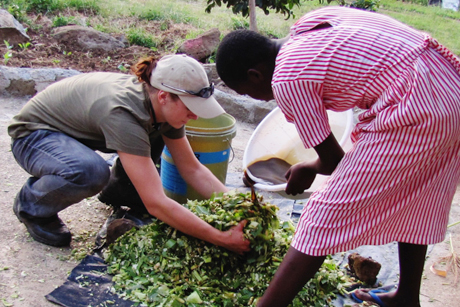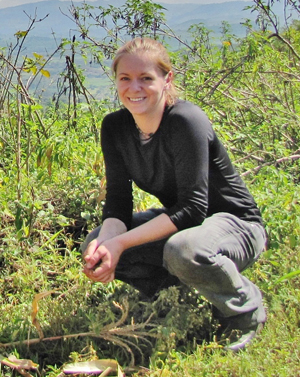Student leads effort to build dairy at Kenyan school
By Stacey Shackford

How many cows are you worth? It’s a question frequently asked by the girls of the Jane Adeny Memorial School in Muhoroni, Kenya, whose dowries will likely be bovine.
Kirstin Torgerson ’15 wants to help make cows even more valuable to the students and their communities by building a safe, sustainable dairy and teaching the girls how to make it successful.
The animal science major recently returned from Chicago, where she started the process of securing $60,000 from Dairies in Developing Communities, a nonprofit affiliated with the investment company, venture | dairy, that aims to increase the efficiency and productivity of small-scale dairy production in emerging markets. The money will be used to construct a 20-25 cow dairy at a private secondary school. Founded by two professors at Northern Illinois University, the school houses 65 students.

Torgerson spent six weeks this past summer on site, conducting a feasibility study for the project and sourcing and pricing building materials. Visits to nearby farms provided insights that helped her shape the facility design. Upon learning that one of the local tribes was famed for cattle rustling, for instance, she designed the dairy stalls so that they would be easy to enter but difficult to exit with cow in tow.
Cows are ubiquitous in rural Kenya. Nearly every household has at least one, and they are considered symbols of wealth. But their productivity is less than a gallon of milk per cow each day (compared with the U.S. average of 6.5 gallons per day). Much of the milk is unsafe, tainted with bacteria levels as high as 35 million cells per milliliter of milk (compared with the world standard of 200,000), and the prices it commands are inconsistent, Torgerson said.
Construction is set to begin in December. The design is simple, so as not to intimidate local farmers who may want to replicate the operation at their own sites, and sustainable, with solar panels, rainwater collectors and a methane digester to manage waste and generate energy.
When she returns to Kenya next summer, Torgerson will buy the first five cows and help calve them. She will then train a farm manager and students in day-to-day and long-term operations, and deliver a curriculum she is now developing. It will include lessons in food safety, pasteurization and marketing – lessons Torgerson learned at Cornell. The Wisconsin native grew up on a beef, sheep and llama farm, but had no dairy experience prior to coming to Ithaca.
By teaching the girls how to care for cows and safely handle and process the milk they produce, she hopes to enhance their nutrition and that of the surrounding community. Torgerson also hopes to influence the girls’ livelihoods by providing them with opportunities for future product development, such as yogurt or cheese, and knowledge they can apply on their own family farms once they graduate. Shared with others in their communities, those lessons will have a ripple effect that could make a marked difference across the region within a generation, Torgerson said.
“There’s just so much potential in dairy,” Torgerson said. “World hunger is not a hopeless challenge. It starts with teaching the very basics of agriculture to farmers. We’re going for a ground-up approach.”
“She continues to amaze me at her capacity for growth and true learning, and the immediate translation of that gained knowledge into something she can apply to improve other people’s lives,” said animal science professor Michael Van Amburgh. “She is truly compassionate and embodies the [College of Agriculture and Life Sciences] concept of knowledge for a public purpose.”
Stacey Shackford is staff writer for the College of Agriculture and Life Sciences.
Media Contact
Get Cornell news delivered right to your inbox.
Subscribe